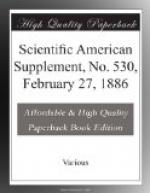We add some special recipes for the various colors, the mordant for all of them being of 3 per cent. chromate of potash and 21/2 per cent. tartar for 100 by weight of dry wool.
1. Orange, Brown Touch. 20 kil. wool, mordant with 600 grm. chromate of potash and 500 grm. tartar, dye with 3 kil. alizarine orange W.
2. Ponceau, Yellow Touch.
20 kil. wool, mordant as for No. 1, dye with 2 kil. alizarine red WR 20 per cent.
3. Ponceau, Blue Touch.
20 kil. wool, mordant like No. 1, dye with 2 kil. alizarine red WB 20 per cent.
4. Dahlia.
20 kil. wool, mordant like No. 1, dye with 5 kil. galleine W.
5. Green.
20 kil. wool, mordant like No. 1, dye with 6 kil. coeruleine W.
For Piece-goods.
20 kil cloth, mordant the same, dye with 1 kil. 200 grm. coeruleine SW.
6. Blue, Bright.
20 kil. wool, mordant the same, dye with 6 kil. alizarine blue WX.
For Piece-goods.
20 kil. cloth, mordant the same, dye with 1 kil. 200 grm. alizarine blue SW.
7. Blue, Dark and Red Touch.
20 kil. wool, mordant like No. 1, dye with 6 kil. alizarine blue WR.
For Piece-goods.
20 kil. cloth, mordant the same, dye with 1 kil. 200 grm. alizarine blue SRW.
Particular stress is to be laid upon the great fastness of the alizarine dyes against light and fulling. Besides, these dyestuffs contain nothing whatever injurious to the wool fiber. Sanders, which very much tenders the wool, as every dyer knows, can in all cases be replaced by alizarine red and alizarine orange, making an end to the spinners’ frequent complaints about too much waste.
Alizarine blue in particular seems to be destined to replace indigo in the majority of its applications, having at least the same power of resisting light and acids, and relieving the dyer of the troublesome, protracted rinsings required for indigo dyed goods. Every piece-dyer knows that the medium and dark indigo blue goods still rub off, even after eight hours’ rinsing; but alizarine blue pieces are perfectly dyed through and clean after one hour of rinsing. Another advantage of alizarine blue and the other alizarine dyestuffs is that they unite with all wood colors, as well as with indigo carmine and all aniline dyestuffs. A fine and cheap dark blue, for instance, is obtained by mordanting the wool as above stated and dyeing (20 kil.) in the second bath with 6 kil. alizarine WX and 2 kil. logwood chips; the wood is added to the bath together with the alizarine blue WX, and the best method is to put it into a bag which is hung in the bath.—D. Woll.-Gew.; Tex. Colorist.




